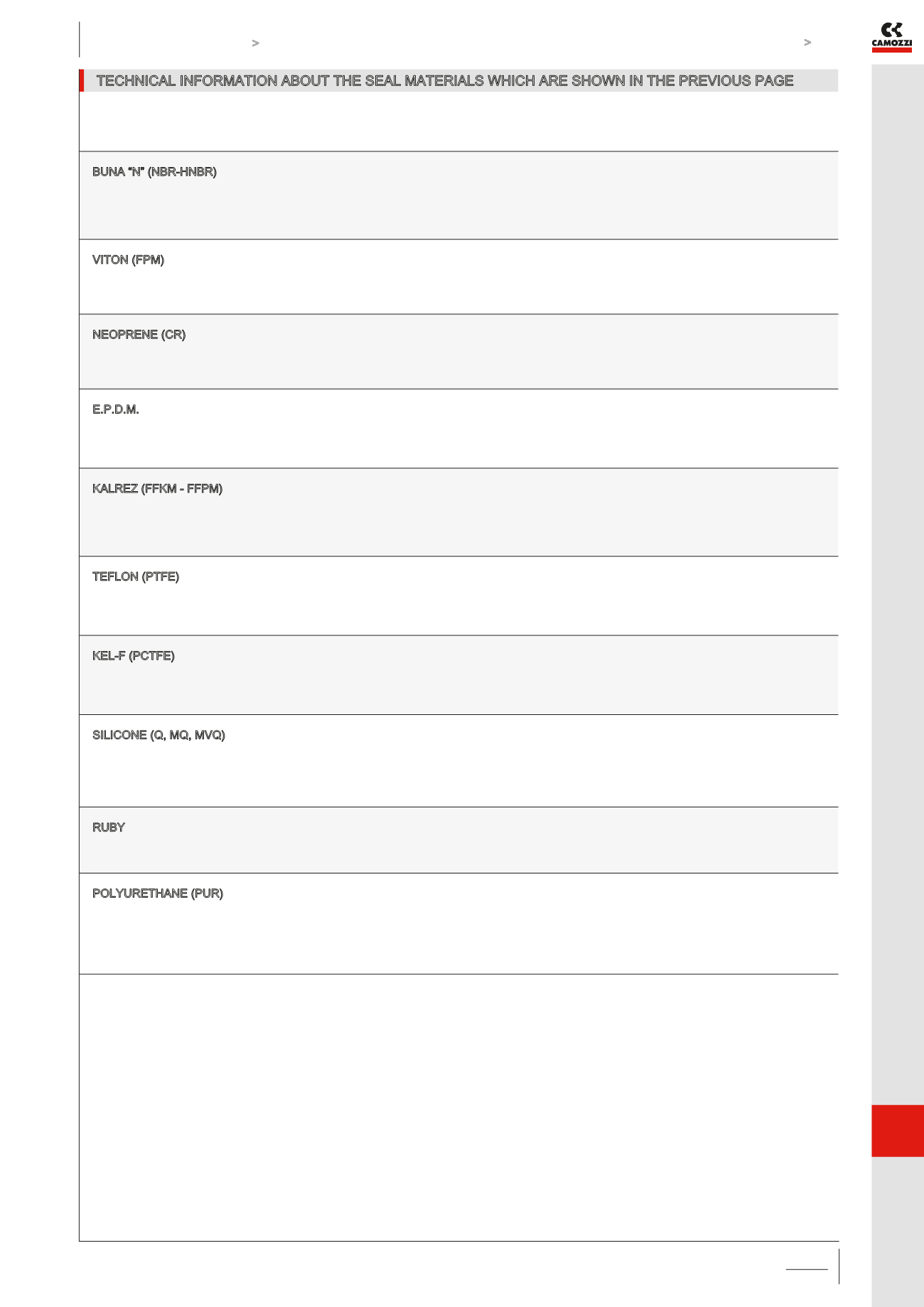

C_FLUID CONTROL CATALOGUE
>
2018
General terms and conditions for sale are available on
www.camozzi.com.a
APPENDIX
APPENDIX >
Info
a
/2
06
This information doesn’t imply on the part of our company any responsibility. This data is provided for information only.
We thus suggest that you contact our technical support staff.
BUNA “N” (NBR-HNBR)
Nitrile rubber. This is a mix of polymers based on butadiene which is being used with aliphatic hydrocarbons (propane, butane, oils and mineral
fats, oils and petroleum gas, kerosene), with air, water, soft acids, alcohols and with turpentine. The use of this rubber is not recommended
with aromatic essences, polar solvents and with strong acids. NBR shows good mechanical properties and has very high abrasion resistance.
On the contrary, it is not resistant to oxygen, ozone and light. Operating temperature: from -20°C to +100°C.
VITON (FPM)
Fluorocarbon rubber. It has excellent resistance to high temperatures, ozone, oxygen and light. It is resistant to mineral oils, fuels, hydraulic
fluids, organic solvents and to forced vacuum. On the contrary it is not resistant to halogen hydrocarbons and to freon. It is not recommended
to be used at low operating temperature. Operating temperature: from -10°C to +200°C.
NEOPRENE (CR)
Chloroprene rubber. It is suitable for use with alcohols, soft acids, air, water, acetone and neutral gases. It has moderate resistance to oils. It
is used in refrigeration systems using oils with high aniline points. Chloroprene shows in general good ozone and aging resistance. It has good
mechanical resistance at every working temperature. Operating temperature: from -30°C to +100°C.
E.P.D.M.
Ethylene-propylene-diene rubber derives from the ethylene and propylene copolymerization. It is recommended to be used with hydraulic fluids
based on phosphates esters and with brake fluids based on glycols, with hot water and steam with temperatures up 150°C, as well as with polar
solvents. It is oxygen, ozone and light resistant. Operating temperature: from -40°C to +130°C.
KALREZ (FFKM - FFPM)
Perfluoro rubber having the same chimical properties as PTFE (TEFLON) and the same elastic properties as FPM (VITON) rubber. It is
chemically compatible with almost every chemicals, in particular it is recommended to be used with corrosive fluids. It is oxygen, ozone and
aging resistant. It is also suitable for use at high temperatures with forced vacuum. It is not recommended for use with fluorinated combined fluids
like freon. Operating temperature: from -20°C to +250°C.
TEFLON (PTFE)
Polytetrafluoroethylene. PTFE has almost absolute chemical resistance. It is not suitable for use with melted alkaline metals, nor with fluorinated
combinations at high pressure and high temperature, nor with some halogen units. It doesn’t show any particular problem of absorption in the
presence of fluids like water. Operating temperature: from -150°C to +180°C.
KEL-F (PCTFE)
Polychlorotrifluoroethylene polymer (CTFE). It is suitable for use with most of corrosive chemicals, organic solvents, hot water and steam,
chlorate gases, cryogenic liquids. PCTFE is not recommended for use with some halogen products. It is light and radiation resistant.
Operating temperature: from -50°C to +180°C.
SILICONE (Q, MQ, MVQ)
“Silicone rubber” includes various rubber-like materials composed of methyl-vinyl silicone. It is suitable for use with motor or transmission oils and
with animal and vegetables fats and oils. It is not recommended to be used with steam, silicone fats and oils, fuels and aromatic hydrocarbons.
It is weatherproof, ozone and aging resistant and shows physiologically neutral properties. It has good resistance to low and high temperature.
Operating temperature: from -50°C to +190°C.
RUBY
Synthetic ruby corundum is inert to all the chemical agents and is resistant to high temperatures.
Synthetic ruby is generally used as siphon nozzle, batching plant nozzles, burner nozzles and valves.
POLYURETHANE (PUR)
Polyurethane rubber can be, according to its poli oil components, both in polyester-urethane (AU) and in polyeter-urethane (EU). The last
one shows better resistance to hydrolysis and it is used with pure aliphatic hydrocarbons, oils and mineral fats or with silicone, as well as with
water temperatures of up to 50°C. It is not recommended to be used with hot water and with steam, esters and eters, alcohols and glycols.
Polyurethane shows excellent abrasion resistance compared with other elastomers and has great elasticity. It has also excellent ozone and
aging resistance. Operating temperature: from -30°C to +80°C.
TECHNICAL INFORMATION ABOUT THE SEAL MATERIALS WHICH ARE SHOWN IN THE PREVIOUS PAGE



















